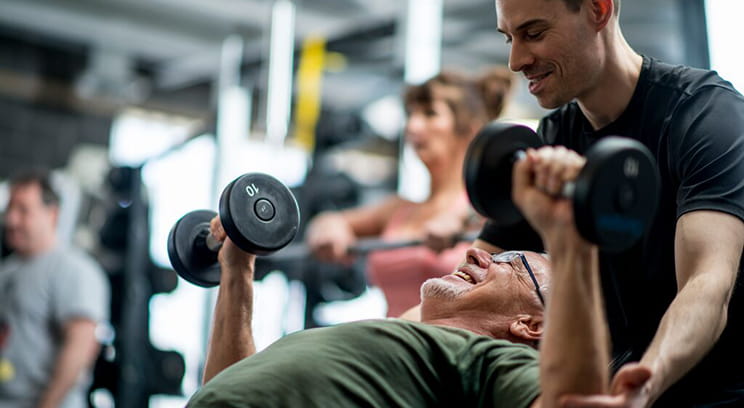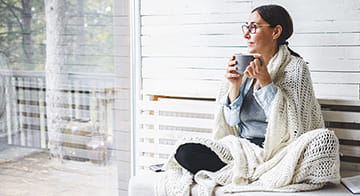Within the last century we have seen astounding increases in global life expectancy. At the start of the 20th century, the average person’s lifespan was just 31 years1. In the 21st century, this has more than doubled, and in many countries people are now living well into their 80s.2
Thanks to medical science, certain conditions that were once seen as an inevitable part of growing older, can now be much more effectively treated and in some cases avoided altogether. Nevertheless, because of our aging population, we are seeing age-related chronic conditions becoming more common.3 Osteoarthritis and osteoporosis are two such conditions that both affect the bones. While they may sound similar, they are quite different in terms of how they present and the treatment they require.4
What is osteoporosis?
Osteoporosis is a condition where bones lose density, causing them to become weak and more likely to fracture. Worldwide, about one in three women and one in five men over 50 will break a bone because of osteoporosis.5
What is osteoarthritis?
Osteoarthritis is a common type of arthritis. It is a degenerative disease that causes cartilage on the ends of bones to become rough and thin, leading to pain and stiffness. The World Health Organisation has estimated an increase of 113% for those living with osteoarthritis between 1990 and 2019.6
Because of the natural ageing process, our chance of developing these conditions increases as we get older. Although there is no definitive cure for either condition, and while medications may help, the mainstay of treatment and/or management focuses on lifestyle and exercise. If you experience severe pain or find that the condition is having a large impact on your life, your GP or family doctor might refer you to a specialist to discuss whether surgery may be an option.
Prevention of osteoporosis and osteoarthritis
With conditions like osteoarthritis and osteoporosis, it is never too soon to start making changes that may help to reduce your risk.
Some of these risk factors cannot be changed, such as age, gender, or family history. However, some risk factors, such as being overweight, following an unhealthy diet, or smoking or drinking too much, can be modified, or controlled with lifestyle changes.
Keeping a healthy body weight
Being overweight can increase the strain on your joints and increases your risk of osteoarthritis of the knee, hand, and hip. Losing even a little weight can reduce the stress on your joints, improving your symptoms. This can be achieved by making changes to your diet and reviewing your activity levels.
Being underweight can also increase your risk of osteoporosis.7 Bones lose density quicker if you are underweight, becoming weak and more likely to fracture.
So, what steps can you take to stay healthy and keep your bones strong?
Keeping a balanced diet
A varied, well-balanced diet can help you maintain a healthy weight and help prevent osteoarthritis and osteoporosis.
In childhood, a healthy diet is important to help build bone mass. For adults, a well-balanced diet helps to preserve bone mass and strength. Foods rich in calcium are essential to keep your bones healthy.
To absorb calcium properly your body needs vitamin D. You can find vitamin D in certain foods like egg yolks and oily fish, but the best source of vitamin D is sunlight. During autumn and winter, the sun usually isn’t strong enough for the body to make enough vitamin D, and UK Government advice is that everyone should consider taking a daily vitamin D supplement during winter months. Supplements should also be considered by people with darker skin, who’s pigment limits the amount of vitamin D their bodies are able to create from sunlight, and those whose circumstances mean they are unable to access much daylight.8
Accessing physical activity
Strength training, weight-bearing aerobic activities, and flexibility exercises are all great for bone health and preventing osteoporosis.
Physical activity is not just good for your general health, it also helps to keep bones strong9 and can reduce your risk of falls by strengthening muscles, increasing flexibility, and improving balance. Exercise plays an important role in building bone mass in children and slowing down bone loss in adults. Strength training, weight-bearing aerobic activities, and flexibility exercises are all great for bone health and preventing osteoporosis.
However, an overactive lifestyle, such a playing sport professionally, may increase your risk of osteoarthritis because repetitive activity can injure your joints. It is about striking the right balance between exercise and rest.
Osteoporosis, and to some extent osteoarthritis, are silent diseases. Osteoporosis is not commonly associated with pain, and you may be unaware of the disease until you break a bone or have a noticeable reduction in height. It’s important to look out for early warning signs which include receding gums, decreased grip strength, weak and brittle fingernails, and lower levels of general fitness, and seek medical advice as soon as possible if you think you’re experiencing symptoms.



